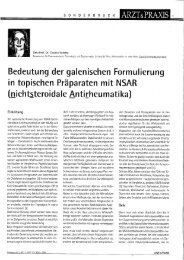Diclofenac Sodium 4% Spray Gel - cyathus.cz
Diclofenac Sodium 4% Spray Gel - cyathus.cz
Diclofenac Sodium 4% Spray Gel - cyathus.cz
You also want an ePaper? Increase the reach of your titles
YUMPU automatically turns print PDFs into web optimized ePapers that Google loves.
PAR <strong>Diclofenac</strong> <strong>Sodium</strong> <strong>4%</strong> <strong>Spray</strong> <strong>Gel</strong><br />
UK/H/0562-3/001/E01<br />
<strong>Diclofenac</strong> sodium, in contrast to other NSAIDs, had no effect on the activities of<br />
peroxisomal enzymes or mitochondrial carnitine palmitoyltransferase.<br />
LOCAL TOLERANCE<br />
The local tolerance of DSG <strong>4%</strong> was compared with Voltaren ® Emulgel (1.16% diclofenac<br />
diethylammonium) in a single dermal application study in male NZW rabbits. This was a<br />
GLP-compliant study performed by the Toxicological Research Centre based in Hungary.<br />
<strong>Diclofenac</strong> spray gel <strong>4%</strong> had comparable dermal irritating potential to Voltaren ® Emulgel,<br />
and both were classified as non-irritant (primary irritation index of 0.17).<br />
SPECIAL TOXICITY<br />
Immunotoxicity<br />
Intraperitoneal administration of diclofenac sodium to mice for three consecutive days and<br />
prior to immunisation with sheep erythrocytes (T-cell dependent antigen) markedly reduced<br />
the humoral antibody titre and the number of rosette-forming cells in the spleen.<br />
<strong>Diclofenac</strong> (20µg/ml) reduced allergen-induced histamine release in isolated perfused guinea<br />
pig lungs but stimulated the antigen-dependent first phase and calcium-dependent second<br />
phase of allergic histamine release from human leucocytes.<br />
Hepatotoxicity<br />
Long term clinical use of diclofenac increases serum alanine transaminase levels and may<br />
cause hepatotoxicity. The expert has reviewed possible mechanisms of diclofenac<br />
hepatotoxicity studied in vitro, in vivo and ex-vivo.<br />
<strong>Diclofenac</strong> (1-10mM), like other NSAIDs, produced dose-dependent and time-dependent<br />
hepatotoxicity in vitro. Reactive metabolites formed either through cytochrome P450 or UDPglucuronosyl<br />
transferase catalysis have been implicated. In fact, pre-treatment of rats with<br />
phenobarbitone increased the hepatoxicity of diclofenac in vitro. Acute in vitro cytotoxicity of<br />
diclofenac, has been attributed to its potential oxidative metabolite(s) formed through<br />
constitutive CYP2C11 in rat; whereas covalent binding of diclofenac acyl glucuronide to rat<br />
hepatocellular proteins could be responsible for its hepatotoxicity. Plasma membrane proteins<br />
were the major target of such adducts and it is postulated that the protein adducts may<br />
stimulate an immune reaction against the liver.<br />
In view of the potential hepatotoxicity of diclofenac, especially after long-term use, patients<br />
should be carefully monitored during diclofenac therapy.<br />
Phototoxicity<br />
<strong>Diclofenac</strong> was weakly photoactive (UVA exposure) after a single ip sub-lethal dose of 50-<br />
200mg/kg.<br />
IMPURITIES AND COMPONENTS OF THE SPRAY GEL<br />
The source of diclofenac sodium is a known source already used in other UK licensed<br />
medicines. Drug substance and finished product specification limits proposed for impurities<br />
are acceptable as well as the specification limit for residual solvents and does not raise any<br />
safety concerns.<br />
At the maximum recommended daily dose, up to 3.6mg sodium is applied to the skin, which<br />
is considerably lower than the threshold for declaring the amount of sodium on the label and<br />
24



